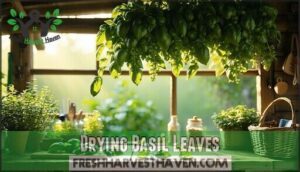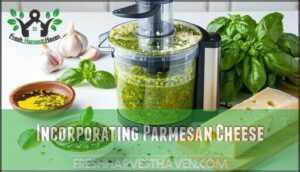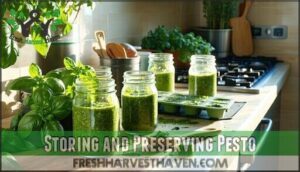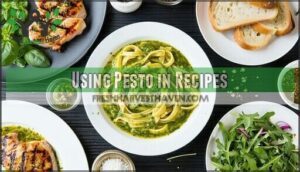This site is supported by our readers. We may earn a commission, at no cost to you, if you purchase through links.
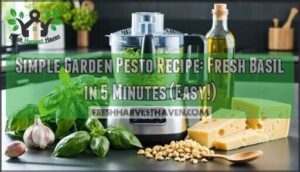
This basic recipe takes just five minutes and transforms your garden’s basil bounty into liquid gold. The key lies in using completely dry basil leaves to prevent a watery mess, and there’s actually a specific technique for harvesting basil that keeps your plants producing all season long.
Table Of Contents
- Key Takeaways
- Simple Garden Pesto Recipe
- Preparing Basil for Pesto
- Making Pesto
- Storing and Preserving Pesto
- Using Pesto in Recipes
- Frequently Asked Questions (FAQs)
- How do you make fresh basil pesto?
- What is a good pesto recipe?
- How do you make a good pesto sandwich?
- How do you make pesto in a food processor?
- What to eat with basil pesto?
- What are the ingredients in pesto?
- How to make simple pesto?
- What is a good substitute for pine nuts in pesto?
- What are the three ingredients in pesto?
- What are the common ingredients of pesto?
- Conclusion
Key Takeaways
- You can make restaurant-quality pesto in just 5 minutes using five basic ingredients: fresh basil, garlic, pine nuts, Parmesan cheese, and olive oil.
- You’ll get the best results by using completely dry basil leaves and pulsing ingredients in stages—nuts and garlic first, then basil with oil, and finally the cheese.
- You can easily substitute ingredients like walnuts for pine nuts, nutritional yeast for Parmesan, or spinach for basil to create budget-friendly or dietary-specific versions.
- You’ll preserve your pesto’s freshness by storing it in airtight containers with a thin olive oil layer on top, or freeze it in ice cube trays for convenient portion-sized servings that last months.
Simple Garden Pesto Recipe
You can transform fresh basil from your garden into vibrant pesto sauce using just five simple ingredients.
This traditional recipe combines basil leaves, garlic, pine nuts, Parmesan cheese, and olive oil to create a multifaceted sauce that’s ready in minutes.
Key Ingredients for Pesto
Creating outstanding pesto starts with five fundamental ingredients that work in perfect harmony. You’ll need fresh basil as your foundation – its vibrant flavor profiles define authentic pesto. Garlic cloves add essential sharpness, while quality olive oil creates a silky texture. Pine nuts provide richness, though walnuts work as nut selection alternatives. Parmesan cheese delivers vital umami depth.
Consider exploring different basil varieties like Genovese for a traditional taste or experimenting with various pesto oils and cheese options to customize your signature blend perfectly.
Substitutions for Traditional Pesto Ingredients
Don’t stress about missing pine nuts or Parmesan cheese. Walnuts and sunflower seeds make excellent nut alternatives, while nutritional yeast creates perfect vegan pesto.
Try spinach or arugula for herb variations beyond traditional basil pesto. Avocado oil works as oil replacements too.
These seed substitutes and vegan cheese options keep your pesto fresh and budget-friendly. For a detailed guide on making pesto, consider checking nut free recipes.
Preparing Basil for Pesto
You’ll want to start with fresh, dry basil leaves to get the best flavor in your pesto. Clean your basil gently with cool water, then pat it completely dry with paper towels to prevent your pesto from becoming watery.
Choosing The Right Basil Variety
Genovese basil stands out as the champion for authentic basil pesto. This Italian variety delivers intense fragrance and complex flavor that grocery store sweet basil simply can’t match.
Genovese basil delivers the intense fragrance and complex flavor that makes authentic pesto superior to grocery store varieties
Your basil selection matters – Genovese’s tender basil leaves create silky texture while climate factors and soil conditions in Liguria produce exceptional leaf quality. Garden fresh basil varieties differ substantially, but for variety comparison, nothing beats Genovese’s intense profile in traditional basil pesto recipes.
The unique characteristics of Genovese basil can be attributed to its European Union certification, which ensures its high quality and distinct flavor.
Harvesting and Cleaning Basil Leaves
Basil leaf selection timing matters most during morning hours when oils peak. Select vibrant, unblemished basil leaves while removing yellowed ones.
You’ll want to pinch stems above leaf pairs using clean scissors—this promotes healthy garden fresh basil regrowth.
Fresh herb handling requires gentle care during leaf washing techniques. Rinse your fresh basil under cool water briefly to eliminate dirt and basil pests control residue, but don’t soak them—they’ll bruise and lose essential oils needed for perfect basil pesto.
Drying Basil Leaves
Once your basil leaves are clean, proper herb drying extends basil shelf life considerably. Basil dehydration preserves flavor for basil pesto and other basil recipes.
Bundle stems together and hang upside down in a warm, dry spot for leaf preservation. This fresh storage method takes one to two weeks but maintains ideal color and taste for your fresh basil throughout the winter months.
Making Pesto
You’ll transform your fresh basil into vibrant pesto using a simple three-step process that takes just minutes.
Start by pulsing pine nuts and garlic in your food processor, then add the basil leaves with olive oil, and finally incorporate the Parmesan cheese for that perfect creamy finish.
Processing Nuts and Garlic
Once your basil is prepped, it’s time to build your pesto’s foundation. Drop pine nuts into your food processor and pulse for 15 seconds until roughly chopped. Nut roasting beforehand deepens flavor, though fresh nuts work fine too.
Add garlic cloves next—start with one if you’re garlic-shy, or go bold with three. Garlic pressing isn’t necessary here; the food processor manages everything. Pulse again until the garlic mingles with nuts, creating fragrant chunks.
This spice blending step sets your pesto recipe’s flavor profile. The chopped mixture should look rustic, not powdery. Flavor enhancement comes from this careful balance—too much processing turns nuts into butter, while too little leaves chunky bits that won’t distribute evenly throughout your final sauce.
Adding Basil and Olive Oil
Now you’ll toss fresh basil leaves into the processor with your processed nuts and garlic. Add a pinch of salt to improve basil quality and flavor enhancement.
Slowly drizzle high-quality extra virgin olive oil while the machine runs—this creates proper herb blending and aroma balance. **The oil selection transforms your homemade pesto recipe into aromatic excellence.
Incorporating Parmesan Cheese
Once you’ve achieved that perfect basil-oil harmony, it’s time for the cheese magic. Grate fresh Parmesan cheese directly into your processor and pulse briefly. This cheese selection brings umami enhancement that elevates your pesto recipe from good to exceptional. The salty, nutty flavor profiles create depth alongside your fresh basil, olive oil, and garlic cloves.
Consider these cheese alternatives for different nutritional value:
- Aged Pecorino Romano for sharper bite
- Nutritional yeast for vegan options
- Asiago for mild sweetness
- Grana Padano for budget-friendly choice
- Goat cheese for tangy creaminess
Storing and Preserving Pesto
You’ll want to store your fresh pesto properly to maintain its vibrant color and flavor for weeks ahead.
Refrigerate pesto in airtight containers for up to one week, or freeze it in ice cube trays for convenient portion-sized servings that last up to three months.
Refrigerating Pesto
Store leftover pesto in airtight containers and add a thin layer of olive oil on top. This prevents oxidation and maintains a vibrant color. The oil creates a protective barrier against air exposure.
Proper refrigeration keeps your pesto storage fresh for up to a week. Stir before using—separation is normal and doesn’t affect quality.
Freezing Pesto in Ice Trays
Freeze your leftover pesto in ice cube trays for perfect portion control. Each pesto ice cube equals roughly one tablespoon—ideal for single servings. Fill trays completely, then freeze pesto overnight. Once solid, pop out frozen herb storage cubes and transfer to labeled freezer bags. This pesto preservation method prevents waste and gives you instant flavor boosters.
Frozen sauce benefits you’ll love:
- No more guessing portions when you’re cooking pasta
- Cubes thaw in minutes, making weeknight dinners easy
- Your homemade pesto stays vibrant green for months
- Perfect ice tray tips for busy home cooks
Maintaining Pesto Freshness
Proper storage methods transform your homemade pesto from a four-day wonder into a fresh basil powerhouse. Keep your airtight container nearly full, then drizzle olive oil over the surface—this simple barrier prevents oxidation and maintains that vibrant green color.
Check for pesto spoilage signs like off-odors or mold before use. Freezing pesto in ice trays extends pesto shelf life up to two months.
These freshness tips and food storage tips guarantee ideal flavor preservation for your garden-to-table creation.
Using Pesto in Recipes
You’ll find that fresh pesto transforms ordinary meals into something special. Use it to coat pasta, spread on sandwiches, marinate chicken, or mix into roasted vegetables for instant flavor.
Pairing Pesto With Pasta and Grilled Meats
Your fresh pesto transforms simple pasta into Italian cuisine magic. Toss it with linguine or penne for perfect coating and authentic flavor combinations.
For grilled meat marinades, mix pesto with olive oil to create summer recipes that improve chicken, steak, and fish.
The basil, Parmesan cheese, and garlic combination elevates ordinary pesto pasta dishes into restaurant-quality meals that capture the essence of fresh garden ingredients.
Using Pesto as a Marinade or Spread
Your homemade pesto sauce works wonders beyond pasta dishes. Here are four creative marinade techniques and spread recipes:
- Brush pesto marinade on chicken breasts before grilling for herb-infused flavor
- Spread basil pesto on crusty bread for an instant appetizer
- Mix pesto into cream cheese for elevated pesto dips
- Use as flavor enhancers for roasted vegetables and potatoes
Experimenting With Pesto Variations
Beyond marinades and spreads, you can craft endless pesto variations by swapping ingredients. Herb blends like arugula-mint or cilantro-basil create unique flavor profiles. Replace pine nuts with walnuts for nutty textures, or use nutritional yeast for vegan alternatives. These creative basil recipes transform your garden harvest.
| Traditional Base | Creative Swap |
|---|---|
| Basil + Pine Nuts | Arugula + Walnuts |
| Parmesan Cheese | Nutritional Yeast |
| Sweet Basil | Purple Basil + Mint |
| Pine Nuts Only | Sunflower Seeds Mix |
Frequently Asked Questions (FAQs)
How do you make fresh basil pesto?
Blend fresh basil leaves, garlic, pine nuts, and Parmesan in a food processor. Slowly drizzle olive oil while pulsing until smooth. Season with salt and pepper to taste.
What is a good pesto recipe?
Don’t beat around the bush—you’ll need fresh basil, garlic, pine nuts, Parmesan, and olive oil.
Pulse basil and nuts first, add garlic and cheese, then drizzle oil while blending until smooth.
How do you make a good pesto sandwich?
Start with crusty bread, then spread pesto generously on both slices. Layer fresh mozzarella, ripe tomatoes, and arugula.
The key’s balancing creamy cheese with tangy tomatoes—it’s like summer between two slices.
How do you make pesto in a food processor?
Want perfectly smooth pesto every time? Combine basil, garlic, and pine nuts in your food processor first. Pulse briefly, then add cheese.
With processor running, slowly drizzle olive oil until you’ve got that silky texture you’re craving.
What to eat with basil pesto?
You’ll love pesto with pasta, naturally, but don’t stop there. Spread it on sandwiches, toss with roasted vegetables, or drizzle over grilled chicken and fish for instant flavor magic.
What are the ingredients in pesto?
You’ll need five simple ingredients: fresh basil leaves, garlic cloves, pine nuts (or walnuts), grated Parmesan cheese, and good-quality olive oil.
These combine beautifully to create that classic vibrant green sauce.
How to make simple pesto?
The simplest things are often the most rewarding. **Pulse fresh basil, garlic, and pine nuts in your food processor.
** Add Parmesan cheese, then drizzle olive oil while blending until smooth. Season with salt and pepper—you’ve created magic.
What is a good substitute for pine nuts in pesto?
Walnuts work beautifully as your go-to pine nut substitute. They’re cheaper and easier to find. Toast them lightly first for deeper flavor.
Almonds, pecans, or sunflower seeds also work well in your homemade pesto.
What are the three ingredients in pesto?
Traditional pesto contains five core ingredients, not three: fresh basil leaves, garlic, pine nuts, Parmesan cheese, and olive oil. You’ll blend these together for that classic, vibrant green sauce.
What are the common ingredients of pesto?
Don’t put all your eggs in one basket—pesto’s magic comes from five key ingredients working together.
You’ll need fresh basil leaves, garlic cloves, pine nuts, Parmesan cheese, and quality olive oil to create this vibrant sauce.
Conclusion
Sure, you might think homemade pesto takes forever, but this simple garden pesto recipe proves otherwise. **You’ve just learned how to transform fresh basil into restaurant-quality sauce in five minutes flat.
**
The secret lies in proper preparation and quality ingredients. Don’t let your basil harvest go to waste when you can create this adaptable condiment so easily. Your pasta nights will never be the same again.
- https://www.simpleecology.com/recipes/zero-waste-garden-pesto
- https://www.thepioneerwoman.com/food-cooking/recipes/a43146411/best-pesto-recipe/
- https://thesuburbansoapbox.com/the-very-best-basil-pesto-recipe-and-tips/
- https://www.thekitchn.com/best-pesto-method-skills-showdown-23345584
- https://www.healthline.com/nutrition/is-pesto-healthy



